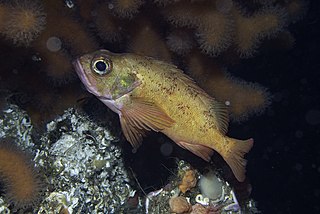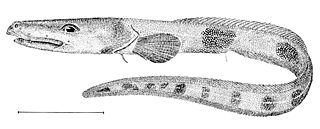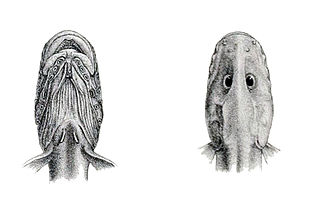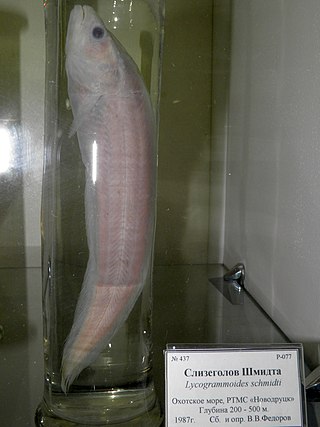
The viviparous eelpout, also known as the, viviparous blenny and European eelpout is species of marine ray-finned fish belonging to the family Zoarcidae, the eelpouts. It is notable for being ovoviviparous and gives birth to live larvae. It is a common soup ingredient in Mediterranean countries. The bones are of greenish colour, due to a harmless pigment. Their skin is slimy and the colour is variable.
Zoarces is a genus of marine ray-finned fishes belonging to the family Zoarcidae, the eelpouts. It is the only genus in the subfamily Zoarcinae. These eelpouts are found in the northern Atlantic and northern Pacific Oceans.
Lycodes is a genus of zoarcid fish in the subfamily Lycodinae. It is the most species-rich genus in its taxonomic family as well as in the Arctic Ocean and adjacent waters. They occupy both shallow waters and deeper waters down to 3000 meters. A few species can occur in brackish waters.

Sebastes viviparus, the Norway redfish, small redfish, lesser redfish, Norway haddock, ocean perch or rosefish, is a species of marine ray-finned fish belonging to the subfamily Sebastinae, the rockfishes, part of the family Scorpaenidae. It is found in the northern Atlantic Ocean.
Lycodes vahlii, Vahl's eelpout or the checker eelpout, is a species of marine ray-finned fish belonging to the family Zoarcidae, the eelpouts. It is native to coasts of Northern Atlantic Ocean.

Lycodichthys is a genus of marine ray-finned fish belonging to the family Zoarcidae, the eelpouts. They are found in the Southern Ocean.

Lycenchelys is a genus of marine ray-finned fishes belonging to the family Zoarcidae, the eelpouts. The genus has almost cosmopolitan distribution.
Lycodes terraenovae, also called the Newfoundland eelpout, Atlantic eelpout or fish doctor, is a species of marine ray-finned fish belonging to the family Zoarcidae, the eelpouts. It is found in deep waters of the Atlantic Ocean.
Pachycara crassiceps is a species of marine ray-finned fish belonging to the family Zoarcidae, the eelpouts. It is found in the Eastern Atlantic Ocean.
Lycodinae is a subfamily of marine ray-finned fish belonging to the family Zoarcidae, the eelpouts. These eelpouts are found are in all the world's oceans, with a number of species being found off southern South America.

Austrolycus is a genus of marine ray-finned fishes belonging to the family Zoarcidae, the eelpouts. The two species in this genus are found in the southeastern Pacific Ocean and the western South Atlantic Ocean off southern South America and the Falkland Islands.
Japonolycodes is a monospecific genus of marine ray-finned fish belonging to the family Zoarcidae, the eelpouts. The only species in the genus is Japonolycodes abei. This species is found Northwestern Pacific Ocean off Japan.

Lycenchelys muraena, the moray wolf eel, is a species of marine ray-finned fish belonging to the family Zoarcidae, the eelpouts. It is found in the Arctic and North Atlantic Oceans.
Lycodapus is a genus of marine ray-finned fishes belonging to the family Zoarcidae, the eelpouts. The species in this genus are found in the Pacific and Southern Oceans.
Lycodes esmarkii, Esmark's eelpout or the greater eelpout, is a species of marine ray-finned fish belonging to the family Zoarcidae, the eelpouts. This species is found in the North Atlantic Ocean.
Lycodonus is a genus of marine ray-finned fish belonging to the family Zoarcidae, the eelpouts. The species in this genus are found in the North and Southern Atlantic Ocean. These fishes are sometimes called scutepouts.

Lycogrammoides is a monospecific genus of marine ray-finned fish belonging to the family Zoarcidae, the eelpouts. Its only species is Lycogrammoides schmidti, a rare species of the Sea of Okhotsk in the northwestern Pacific Ocean.
The bearded eelpout is a species of marine ray-finned fish belonging to the family Zoarcidae, the eelpouts. This species is the only species in the monospecific genus Lyconema. It is found in the eastern Pacific Ocean.
Lycozoarces is a monospecific genus of marine ray-finned fish belonging to the family Zoarcidae, the eelpouts, its only species being Lycozoarces regani. It is the only genus in the monogeneric subfamily Lycozoarinae. This taxon occurs in the northwestern Pacific Ocean in the Sea of Okhotsk and the Tatar Strait in the northern Sea of Japan

The Arctic staghorn sculpin is a species of marine ray-finned fish belonging to the family Cottidae, the typical sculpins. This sculpin is found in the Arctic Ocean and the northern Atlantic Ocean.








